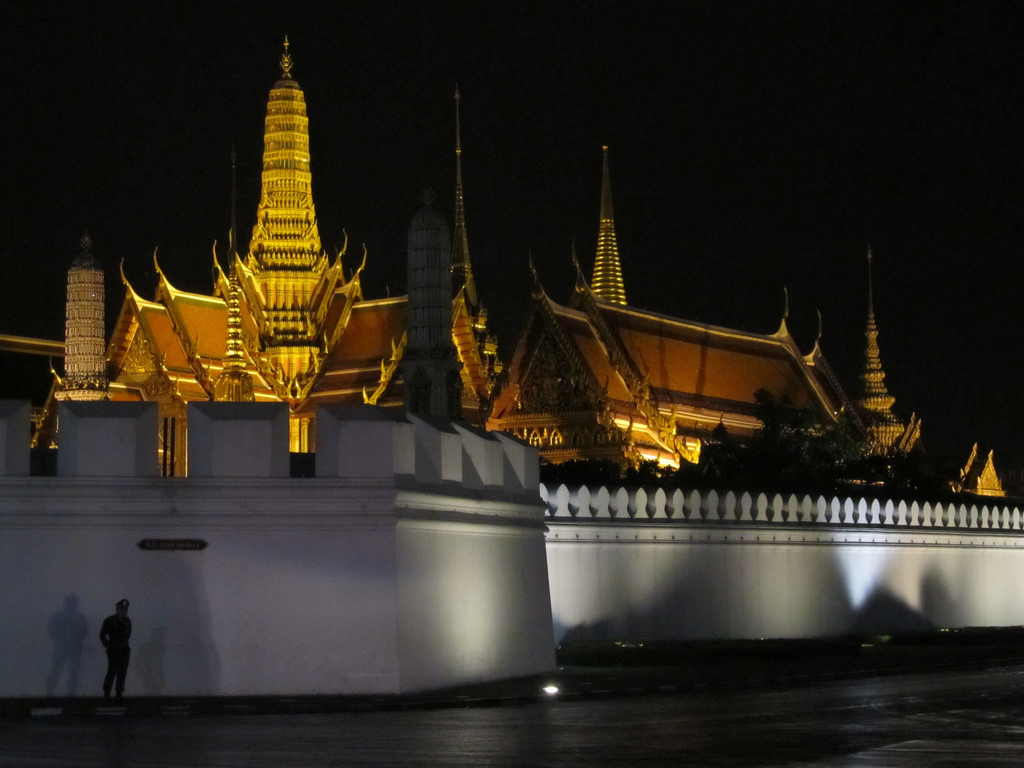
Cheers rang out when the man landed a punch on his opponent.
As the man tried to recover from the blow, the crowd watched on expectantly, as if hypnotized by the pulsating drum beats.
When another well-placed kick landed on its target, applause once again rang out from the approving crowd.

This was not a street brawl, however.
The Muay Thai fight was taking place in the centre of Bangkok’s busiest and most vibrant shopping district, outside the Mahboonkrong (MBK) Shopping Centre.

Long synonymous with Thai culture, Muay Thai is also known as the “Art of Eight Limbs” as hands, arms, elbows and knees are used extensively during the fight.
Every night, huge stadiums in Bangkok are packed with exuberant fans that treat each fight as if they were at an NBA playoff game.
Thus, it was no surprise that the once-a-week bout (on Wednesdays) outside MBK had attracted a huge crowd of bystanders.

Having had my fill of the action, I slipped away into the air-conditioned comforts of the numerous shopping malls around the area.
Early the next morning, I made my way to the fairytale-like Grand Palace – undoubtedly the city’s most famous landmark.

Situated on the banks of the brownish waters of the Chao Phraya River, the palace has been the official residence of the Kings of Siam (and later Thailand) since 1782.
Passing through its white walls, I enter the palace complex which contain several buildings including Wat Phra Kaew (Temple of the Emerald Buddha) – home of the small, very famous and greatly revered Emerald Buddha that dates back to the 14th century.

However, the rest of the complex is no less impressive as the buildings are decorated with colorful glass mosaics, gold leaves, delicately carved wood and grand mural paintings.
Just across the river from the Grand Palace is the Wat Arun, a Khmer-style Buddhist temple that’s one of the oldest structures in Bangkok.
To get there, I took a ferry across the river.

The main part of the temple is made up of a tower surrounded by four stupas, but it’s the intricate detail that makes this temple fascinating.
The tower and stupas are ornately decorated with bits of colourful Chinese porcelain and glazed ceramic tiles that make it an impressive work of art.

Seduced though my friends and I were by the bright lights, relentless activity and sprawling malls of Bangkok, we wanted to see other parts of Thailand.
As such, we headed north to an ancient city known as the first capital of Siam – Sukhothai.
The city is over 400 kilometres from Bangkok, so we took a seven-hour overnight train to a town called Phitsanulok before we transferred to a songthaew (converted pick-up truck) for the remaining one hour journey to Sukhothai.

Sukhothai was founded in 1238, and it was the capital of the Thai Empire for approximately 140 years.
Today, only ruins remain, but in a nod to their historical significance, they have been designated as a UNESCO World Heritage Site.

The ruins are spread out over a pretty vast area which is divided into several zones.
After putting down our bags, we grabbed some bicycles and started exploring the ruins.

Inside the park, there are several ruins of royal palaces, Buddhist temples, walls and moats.
But given that we are not historians (and because the ruins started looking similar after a while), we chose to visit only a few highlights.
One of them was Wat Mahathat, the largest and most important Sukhothai temple.

Surrounded by a moat, the temple has a giant seated Buddha behind rows of half-collapsed columns.
Given that there were hardly any other visitors around (probably because Sukhothai is a little remote), we pretty much had the whole site to ourselves.

But while the lack of visitors might make the ruins feel more atmospheric, there is at least one drawback.
On our way to another set of ruins, we took a wrong turn and ended up literally in the middle of nowhere.
As the blistering heat from the midday sun threatened to burn us to a crisp, we continued making one wrong turn after another.

Fortunately, we were finally shown the right way by a farmer on a bullock cart after what seemed like a very long time.
We promptly made our way to Wat Si Chum, which eventually turned out to be my favourite temple within Sukhothai.

The temple complex consists of a large seated Buddha housed within a square, roofless brick building, and it is quite striking, though not just for its setting.
Wearing a serene expression, the Buddha’s right hand is extended downwards to summon the Earth Goddess, and the fingers are around the height of an average person!

Looking at the ruins, it’s not hard to imagine how magnificent Sukhothai would have been in its heyday.
And in fact, after visiting Sukhothai, I was struck by the impermanence of even the greatest cities.

But who knows?
Perhaps one day Sukhothai will rise again to reclaim its past glory.
Till that happens, it will remain in its relative state of slumber, interrupted only by the occasional tourists.




![[Review] Xiaomi Smart Band 10: A S$59 Budget, Yet Stylish and Feature-Packed Wearable for Fitness Enthusiasts [Review] Xiaomi Smart Band 10: A S$59 Budget, Yet Stylish and Feature-Packed Wearable for Fitness Enthusiasts - Alvinology](https://media.alvinology.com/uploads/2025/06/xiaomi-smart-band-02-110x110.jpg)

![[Review] Skechers Electrum Pack SKX_1.5 Elite FG: A Literal Gold Standard in Football Performance [Review] Skechers Electrum Pack SKX_1.5 Elite FG: A Literal Gold Standard in Football Performance - Alvinology](https://media.alvinology.com/uploads/2025/06/skechers-electrum-harry-kane-04-110x110.jpg)



![[GIVEAWAY] Food Republic@Shaw invites YOU for breakfast - 10 x S$15 breakfast vouchers to be won [GIVEAWAY] Food Republic@Shaw invites YOU for breakfast - 10 x S$15 breakfast vouchers to be won - Alvinology](https://media.alvinology.com/uploads/2016/04/food-republic-04.jpg)

